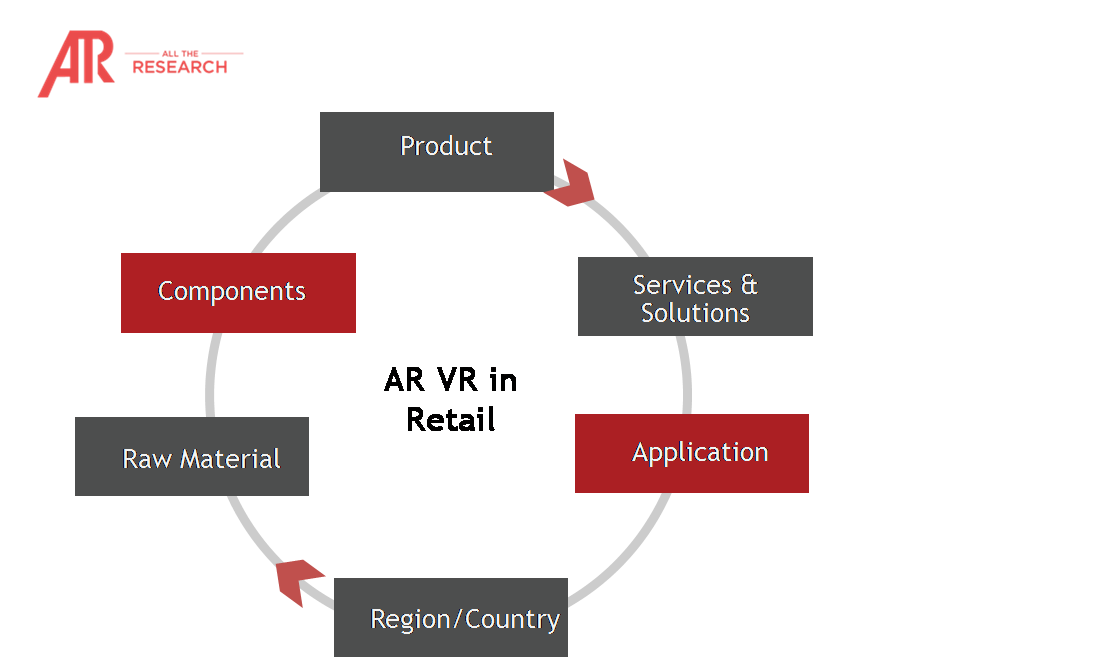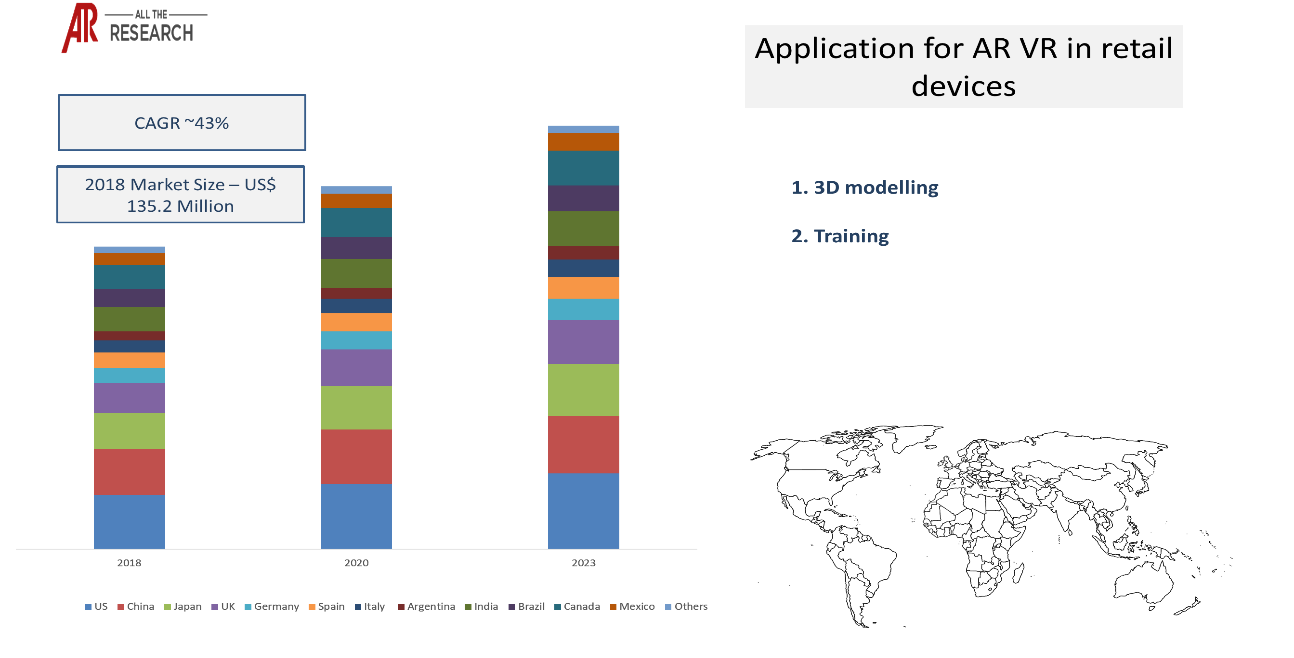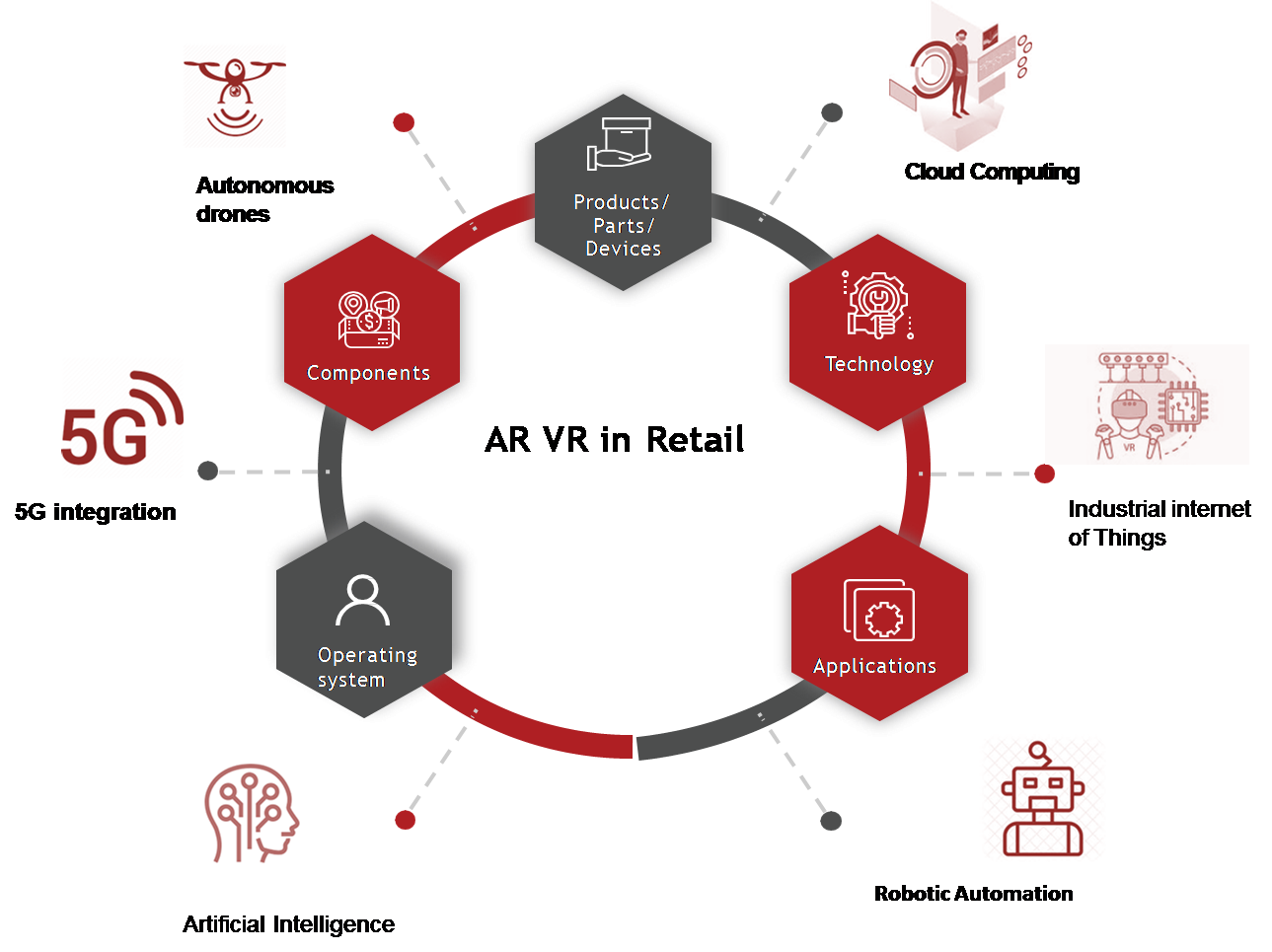The global AR VR in Retail Market Ecosystem was valued at US$ 135.2 Mn in 2018 and is expected to reach US$ XX Mn with a CAGR of 43% during the forecast period. The increasing use of AR VR by retail companies such as IKEA, Houzz, Walmart, and others, has been driving the growth of the AR VR retail market in recent years. IKEA uses AR for home goods and furniture retailing, allowing customers to manipulate and place catalog items at scale in consumer homes.
Changing lifestyles and increasing working-class populations are increasing the demand for virtual reality shopping. In order to meet this changing demand, companies such as Amazon and Walmart are introducing augmented reality-based applications for enhancing customer experience. Moreover, companies are also focusing on using virtual reality for conveying information about products while shopping. For example, the partnership between Kraft, a prepackaged food retailer, Walmart and Blippar, an application provider, for providing digital receipts to customers through AR.

The handheld devices segment accounted for US$ XX Mn in 2018 and is expected to grow with a CAGR of XX% during the forecast period. The increasing use of handheld devices by retailers for promoting their products is driving the growth of the segment. AR VR is used for in-store engagement to assist customers in navigating the store and to give them a virtual feel of products. For instance, Genius app of Loreal allows users to apply makeup products such as eyeliner and lipstick on their face, with smartphone cameras acting as a smart mirror. The application is gaining traction across the globe, and it has been downloaded for more than 16 million times, according to the report provided by Loreal in 2017.
AR VR in retail is also in demand among customers due to its ability to provide customization to users. The AR technology is used by Dulux Color app in its color view feature that enables users to visualize the effect of color on their walls by using smartphones. This, in turn, is driving the demand for handheld devices in AR VR retailing.
|
Raw Materials |
Components |
Products, Parts & Devices |
Software & Services |
Applications |
|---|---|---|---|---|
|
Silicon |
Camera |
Handheld Devices |
Documentation |
3D Modelling/ Design- Shopping |
|
GaN |
Sensors |
AR Screen |
Visualization |
Training |
|
SiC |
IMU |
Head-Mounted Displays |
3D modeling |
|
|
Glass |
Displays |
Smart Glass |
Navigation |
|
|
Plastic |
Processor |
Workflow optimization |
||
|
Metals |
Memory |
Others |
||
|
Others |
Graphics |
|||
|
Audio |
||||
|
Module |
||||
|
Others |
Based on regions, North America dominated the market in 2018 and is expected to witness similar trends in the coming years. The presence of major players such as Loreal, Walmart, Ulta Beauty, and others is driving the growth of AR VR in the retail market ecosystem in the region. Asia Pacific is expected to grow at the fastest pace with a CAGR of XX% during the forecast period. According to a market study in 2016, 28% of Australian retailers are expected to adopt VR in the coming years, which is expected to drive the growth of the VR market in the Asia Pacific region during the forecast period.
The major players in the market are mainly focusing on mergers and acquisitions for strengthening their presence in the market. For instance, in March 2018, Loreal announced the acquisition of Modiface that offers beauty try-on simulations on live video, which include photorealistic hairstyle, hair color, and makeup stimulation. Additionally, in November 2018, Ulta Beauty, a beauty retailer, announced the acquisition of GlamST, a provider of 3D virtual makeup technology, and due to this, users will be able to try makeup via mobile.

There are many trends that are having an impact on the market forecast. These, when evaluated from a company’s perspective, can drive growth. Our numerous consulting projects have generated sizeable synergies across all regions and all sizes of companies.
|
Company |
Ecosystem Positioning |
Total Revenue |
Industry |
Region |
|---|---|---|---|---|
|
Microsoft |
Product Manufacture |
$110.4 Billion |
|
Global |
|
Google LLC
|
Product Manufacture |
$136.22 Billion |
|
Global |
|
Lenovo
|
Product Manufacture |
$14 Billion |
|
Global |
|
HTC Corporation |
Product Manufacture |
$0.73 Billion |
|
Global |
|
|
Product Manufacture |
$55 Billion |
|
Global |
Very few markets have interconnectivity with other markets like AR VR. Our Interconnectivity module focuses on the key nodes of heterogenous markets in detail. Autonomous drones, cloud computing, industrial internet of things, robotic automation, artificial intelligence, and 5G integration markets are some of our key researched markets

|
Trends |
Application |
|---|---|
|
Augmented reality applications are used by jewelry shops to enable customers to try jewelry virtually. Smart mirrors are created by using iPad that generate catalogues of thousands of earrings across the stores as per the customer age. |
Shopping |
|
Interactive retail display is used in retail stores to enable customers to try new clothes. This digital technology provides customers a new immersive experience in retail stores. |
Shopping |

Ask for free product review call with the author

Share your specific research requirements for a customized report

Request for due diligence and consumer centric studies

Request for study updates, segment specific and country level reports
Introduction
